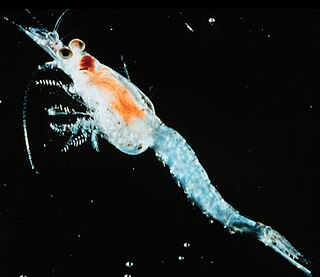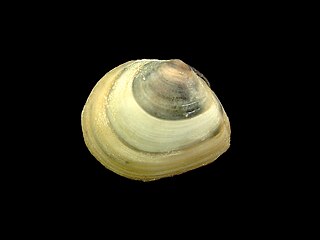
Mysida is an order of small, shrimp-like crustaceans in the malacostracan superorder Peracarida. Their common name opossum shrimps stems from the presence of a brood pouch or "marsupium" in females. The fact that the larvae are reared in this pouch and are not free-swimming characterises the order. The mysid's head bears a pair of stalked eyes and two pairs of antennae. The thorax consists of eight segments each bearing branching limbs, the whole concealed beneath a protective carapace and the abdomen has six segments and usually further small limbs.

Anostraca is one of the four orders of crustaceans in the class Branchiopoda; its members are also known as fairy shrimp. They live in vernal pools and hypersaline lakes across the world, and they have even been found in deserts, ice-covered mountain lakes and Antarctic ice. They are usually 6–25 mm (0.24–0.98 in) long. Most species have 20 body segments, bearing 11 pairs of leaf-like phyllopodia, and the body lacks a carapace. They swim "upside-down" and feed by filtering organic particles from the water or by scraping algae from surfaces. They are an important food for many birds and fish, and some are cultured and harvested for use as fish food. There are 300 species spread across 8 families.

The Baltic Ice Lake is a name given by geologists to a freshwater lake that evolved in the Baltic Sea basin as glaciers retreated from that region at the end of the last ice age. The lake existed between 12,600 and 10,300 years Before Present (BP).

The bloody-red mysid, Hemimysis anomala, is a shrimp-like crustacean in the Mysida order, native to the Ponto-Caspian region, which has been spreading across Europe since the 1950s. In 2006, it was discovered to have invaded the North American Great Lakes.

Mysis is a genus of mysid crustaceans in the family Mysidae, distributed mainly in the coastal zone of the Arctic and high boreal seas. Several species also inhabit northern freshwater lakes and the brackish Caspian Sea. Fifteen species are recognized. Body lengths range from 1 to 3 centimetres.

Theodoxus fluviatilis, common name the river nerite, is a species of small freshwater and brackish water snail with a gill and an operculum, an aquatic gastropod mollusk in the family Neritidae, the nerites.

Pelecus cultratus, commonly known as the ziege, sichel, sabre carp or sabrefish, is a cyprinid fish species from Eastern Europe and adjacent Asian regions, the only one in its genus, inhabiting the lower reaches of rivers and brackish waters in the eastern Baltic Sea, Black Sea, Caspian Sea and Aral Sea basins. The ziege having no major threats, the IUCN lists it as being of Least Concern.

Limecola balthica, commonly called the Baltic macoma, Baltic clam or Baltic tellin, is a small saltwater clam, a marine bivalve mollusk in the family Tellinidae.

Paramysis is a genus of mysid crustaceans (Mysidacea) in family Mysidae, distributed in coastal zone of low boreal East Atlantic Ocean, Mediterranean Sea and the basins of Black Sea, Sea of Azov and Caspian Sea.

Mysis relicta is a shrimp-like crustacean in the Mysida order, native to lakes of Northern Europe and to the brackish Baltic Sea.

Neomysis is a genus of opossum shrimp from the family Mysidae, distributed in the coastal zone of temperate seas of the Northern Hemisphere and South America. Several species, particularly from the West Pacific, are also found in fresh and brackish waters. The genus contains the following 18 species:

Mysis diluviana is a mysid crustacean found in freshwater lakes of northern North America.

Paramysis baeri is a species of mysid crustacean from the genus Paramysis, named in honour of the prominent biologist Karl Ernst von Baer. Its body is 13–31 millimetres (0.51–1.22 in) long, and it is only found in the coastal waters of the Caspian Sea, on sandy and muddy bottoms, at depths of less than 20 m (66 ft). For over a century, it was thought to be distributed throughout the whole Ponto-Caspian basin, but recently the range was reconsidered after the rediscovery and re-establishment of the closely related species Paramysis bakuensis. Since the taxonomical status of P. baeri has been reconsidered, the distribution and ecology of the species remains poorly known. Paramysis baeri can be distinguished from P. bakuensis and other species of the subgenus Paramysis s. str. by the rather broad, almost quadrangular exopod of maxilla 2, the strongly serrated paradactylar claw-setae of pereiopod 6, and other features.
Paramysis bakuensis is a species of mysid crustacean from the family Mysidae, named by the locality from where it was originally described, the town of Baku in Azerbaijan by the Caspian Sea.

Praunus flexuosus, known as the chameleon shrimp, is a species of opossum shrimp found in European waters. It reaches 26 mm (1.0 in) long, with a distinctly bent body, and closely resembles Praunus neglectus. It lives in shallow water and tolerates a wide range of salinities. It is found from northern France to the Baltic Sea, and was introduced to North America in the mid 20th century.
Americamysis bahia is a shrimp-like crustacean in the order Mysida, the opossum shrimps. It is native to estuarine waters in Texas and Florida in the United States. It is often referred to in the literature as Mysidopsis bahia and is widely cultured and used in the laboratory for toxicology testing.
Americamysis almyra is a shrimp-like crustacean in the order Mysida, the opossum shrimps. It is native to estuarine waters in the western Atlantic Ocean and Gulf of Mexico. It is often referred to in the literature as Mysidopsis almyra.

Gastrosaccus spinifer is a shrimp-like crustacean in the order Mysida, the opossum shrimps, native to the eastern Atlantic Ocean and the coasts of Northern and Western Europe.

Heteromysis is a genus of marine mysid crustaceans from the family Mysidae, associated with various shallow-water invertebrates. The name describes differentiation of its pereiopods as possible adaptation to commensal life-style. Heteromysis is one of the largest mysid genera, containing more than 100 species. The genus is distributed globally, but predominantly in tropical and subtropical waters.
Paramysis intermedia is a species of shrimp in the family Mysidae. Its natural distribution is Ponto-Caspian, but it is also invasive species, e.g. on the Baltic coast of Estonia. It tolerates salinities between 0–12 ppt; it occurs in estuaries but does not penetrate very deep into rivers.














